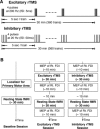Bidirectional effects on interhemispheric resting-state functional connectivity induced by excitatory and inhibitory repetitive transcranial magnetic stimulation
- PMID: 23897535
- PMCID: PMC6869044
- DOI: 10.1002/hbm.22300
Bidirectional effects on interhemispheric resting-state functional connectivity induced by excitatory and inhibitory repetitive transcranial magnetic stimulation
Abstract
Several recent studies using functional magnetic resonance imaging (fMRI) have shown that repetitive transcranial magnetic stimulation (rTMS) affects not only brain activity in stimulated regions but also resting-state functional connectivity (RSFC) between the stimulated region and other remote regions. However, these studies have only demonstrated an effect of either excitatory or inhibitory rTMS on RSFC, and have not clearly shown the bidirectional effects of both types of rTMS. Here, we addressed this issue by performing excitatory and inhibitory quadripulse TMS (QPS), which is considered to exert relatively large and long-lasting effects on cortical excitability. We found that excitatory rTMS (QPS with interstimulus intervals of 5 ms) decreased interhemispheric RSFC between bilateral primary motor cortices, whereas inhibitory rTMS (QPS with interstimulus intervals of 50 ms) increased interhemispheric RSFC. The magnitude of these effects on RSFC was significantly correlated with that of rTMS-induced effects on motor evoked potential from the corresponding muscle. The bidirectional effects of QPS were also observed in the stimulation over prefrontal and parietal association areas. These findings provide evidence for the robust bidirectional effects of excitatory and inhibitory rTMSs on RSFC, and raise a possibility that QPS can be a powerful tool to modulate RSFC.
Keywords: QPS; fMRI; rTMS; rs-fcMRI; transcallosal connection.
Copyright © 2013 Wiley Periodicals, Inc.
Figures




Similar articles
-
Effects of the motor cortical quadripulse transcranial magnetic stimulation (QPS) on the contralateral motor cortex and interhemispheric interactions.J Neurophysiol. 2014 Jan;111(1):26-35. doi: 10.1152/jn.00515.2013. Epub 2013 Oct 9. J Neurophysiol. 2014. PMID: 24108795
-
Association Between Responsiveness to Transcranial Magnetic Stimulation and Interhemispheric Functional Connectivity of Sensorimotor Cortex in Older Adults.Brain Connect. 2023 Feb;13(1):39-50. doi: 10.1089/brain.2021.0180. Epub 2022 Jun 27. Brain Connect. 2023. PMID: 35620910 Free PMC article.
-
Bidirectional long-term motor cortical plasticity and metaplasticity induced by quadripulse transcranial magnetic stimulation.J Physiol. 2008 Aug 15;586(16):3927-47. doi: 10.1113/jphysiol.2008.152793. Epub 2008 Jul 3. J Physiol. 2008. PMID: 18599542 Free PMC article.
-
Rapid modulation of distributed brain activity by Transcranial Magnetic Stimulation of human motor cortex.Behav Neurol. 2006;17(3-4):135-48. doi: 10.1155/2006/287276. Behav Neurol. 2006. PMID: 17148833 Free PMC article. Review.
-
The effects of motor cortex rTMS on corticospinal descending activity.Clin Neurophysiol. 2010 Apr;121(4):464-73. doi: 10.1016/j.clinph.2009.11.007. Epub 2010 Jan 21. Clin Neurophysiol. 2010. PMID: 20096628 Review.
Cited by
-
The alterations of repetitive transcranial magnetic stimulation on the energy landscape of resting-state networks differ across the human cortex.Hum Brain Mapp. 2024 Oct 15;45(15):e70029. doi: 10.1002/hbm.70029. Hum Brain Mapp. 2024. PMID: 39465912 Free PMC article.
-
Different effects of I-wave periodicity repetitive TMS on motor cortex interhemispheric interaction.Front Neurosci. 2023 Jun 30;17:1079432. doi: 10.3389/fnins.2023.1079432. eCollection 2023. Front Neurosci. 2023. PMID: 37457007 Free PMC article.
-
Effects of robotic therapy associated with noninvasive brain stimulation on motor function in individuals with incomplete spinal cord injury: A systematic review of randomized controlled trials.J Spinal Cord Med. 2025 Jan;48(1):6-21. doi: 10.1080/10790268.2024.2304921. Epub 2024 Jan 24. J Spinal Cord Med. 2025. PMID: 38265422 Free PMC article.
-
Effects of rTMS of pre-supplementary motor area on fronto basal ganglia network activity during stop-signal task.J Neurosci. 2015 Mar 25;35(12):4813-23. doi: 10.1523/JNEUROSCI.3761-14.2015. J Neurosci. 2015. PMID: 25810512 Free PMC article.
-
Pre- and post-COVID-19: The impact of the pandemic and stock market psychology on the growth and sustainability of consumer goods industries.Front Psychol. 2022 Nov 18;13:796287. doi: 10.3389/fpsyg.2022.796287. eCollection 2022. Front Psychol. 2022. PMID: 36507039 Free PMC article.
References
-
- Allen EA, Pasley BN, Duong T, Freeman RD (2007): Transcranial magnetic stimulation elicits coupled neural and hemodynamic consequences. Science 317:1918–1921. - PubMed
-
- Barker AT, Jalinous R, Freeston IL (1985): Non‐invasive magnetic stimulation of human motor cortex. Lancet 1:1106–1107. - PubMed
-
- Biswal B, Yetkin FZ, Haughton VM, Hyde JS (1995): Functional connectivity in the motor cortex of resting human brain using echo‐planar MRI. Magn Reson Med 34:537–541. - PubMed
-
- Biswal BB, Mennes M, Zuo X‐N, Gohel S, Kelly C, Smith SM, Beckmann CF, Adelstein JS, Buckner RL, Colcombe S, Dogonowski AM, Ernst M, Fair D, Hampson M, Hoptman MJ, Hyde JS, Kiviniemi VJ, Kotter R, Li SJ, Lin CP, Lowe MJ, Mackay C, Madden DJ, Madsen KH, Margulies DS, Mayberg HS, McMahon K, Monk CS, Mostofsky SH, Nagel BJ, Pekar JJ, Peltier SJ, Petersen SE, Riedl V, Rombouts SARB, Rypma B, Schlaggar BL, Schmidt S, Seidler RD, Siegle GJ, Sorg C, Teng GJ, Veijola J, Villringer A, Walter M, Wang L, Weng XC, Whitfield‐Gabrieli S Williamson P, Windischberger C, Zang YF, Zhang HY, Castellanos FX, Milham MP (2010): Toward discovery science of human brain function. Proc Natl Acad Sci USA 107:4734–4739. - PMC - PubMed
Publication types
MeSH terms
Substances
LinkOut - more resources
Full Text Sources
Other Literature Sources
Medical

